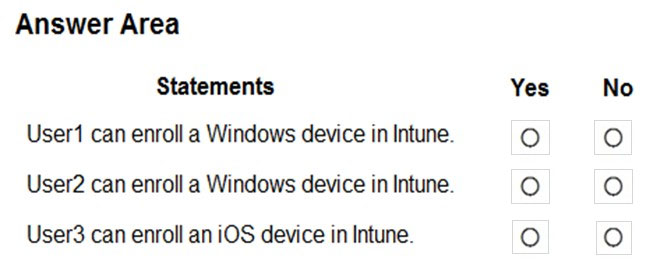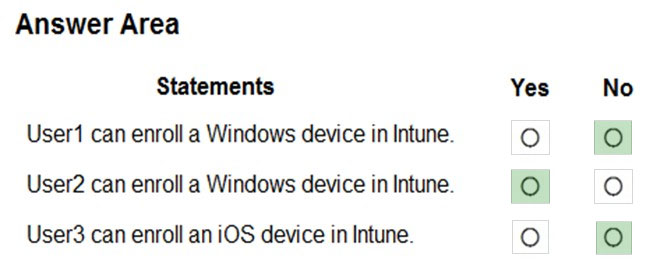

HOTSPOT -
Your company has a Microsoft Azure Active Directory (Azure AD) tenant and computers that run Windows 10.
The company uses Microsoft Intune to manage the computers.
The Azure AD tenant has the users shown in the following table.
The device type restrictions in Intune are configured as shown in the following table:
User3 is a device enrollment manager (DEM) in Intune.
For each of the following statements, select Yes if the statement is true. Otherwise, select No.
NOTE: Each correct selection is worth one point.
Hot Area:

JasiJay
Highly Voted 5 years, 3 months agosasstu
5 years, 2 months agoDJM
4 years, 5 months agoRodrigoT
3 years agoth11
Highly Voted 4 years, 12 months agoDJM
4 years, 5 months agoRodrigoT
2 years, 12 months agobitjos
Most Recent 2 years, 4 months agoTonySuccess
2 years, 7 months agomoobdoob
3 years, 3 months agouns_uns
3 years, 10 months agoTomtom11
3 years, 11 months agoBLYBOI
3 years, 11 months agogeoffC
4 years agosakthivelesec
4 years agoTomtom11
4 years agocubalondon
4 years, 2 months agostromnessian
4 years, 2 months agolucidgreen
4 years, 3 months agoBLYBOI
4 years, 5 months agoj0eyv
4 years, 5 months agoDJM
4 years, 5 months agoDarisha
4 years, 8 months agoMr01z0
4 years, 1 month agojosekast
4 years, 10 months agoDJM
4 years, 5 months agodensyo
3 years, 11 months ago